CKD launches new products to expand further its market share in labor-saving and automatic machineries.
CKD Corporation, based in Komaki City,
Aichi Prefecture manufactures labor-saving and automatic machineries.
It has a
large market share in lighting manufacturing equipment, pharmaceutical
packaging machines, and chemical liquid control equipment for semiconductors.
The slowdown of overseas economies including China caused stagnating growth in
capital investment for rationalization and labor saving by companies although
they had been strong until recently.
As a result, operating income for the fiscal
year ending March 2019 was 5.43 billion yen, down 56.5% from the previous year.
The decline in semiconductor equipment investment and the slowing Chinese
investment to automatic machinery have caused equipment segment profits to fall
sharply.
On the other hand, in Japan where labor
shortages are getting worse, there is an active movement by companies to boost
labor saving investment.
CKD has launched a new product to help workers at
plants lift heavy goods up to 80 kilograms using air pressure.
In consideration
of safety, a new design was adapted in this product to prevent workers from
having their fingers caught in joints.
CKD aims for sales of 800 million yen in
fiscal 2021 in Japan and overseas that are suffering from aging workers and
labor shortages.
In addition, it will launch a high-performance camera that can
check pharmaceutical packaging in 1 mm increments.
Using these cameras, it has
developed a new inspection system for the pharmaceutical products such as
tablets and capsules.
The system detects the position and print displacement of
each sheet of medicine in 1 mm units so that the risk of cutting bar codes
carrying the information in the middle is reduced.
The price of this newly
developed system ranges from 8 million yen to 20 million yen.
Its sales person
said that several products have already been shipped and customer’s interest
continues to be high.
The market of factory cameras used for inspection and
production is expected to grow to 188 billion yen in 2020, expanding 30%
compared from 2016 and further demand can also be expected from food and
cosmetics companies as well as electronic parts and semiconductors
manufacturers.





Comments
Post a Comment